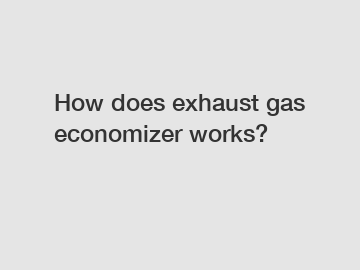How does exhaust gas economizer works?
In today's era of growing environmental consciousness, the quest for sustainable energy solutions is of paramount importance. One such innovation that has revolutionized the marine and industrial sectors is the exhaust gas economizer. This state-of-the-art technology harnesses untapped energy potential, reducing emissions and enhancing fuel efficiency. In this blog post, we will delve into the inner workings of an exhaust gas economizer and understand how it contributes to a greener and more economically feasible future.
1. The Need for Energy Conservation:
In an era grappling with climate change concerns, the marine and industrial sectors are under pressure to minimize their carbon footprint. Ships and industries generate large volumes of waste heat through exhaust gases, which traditionally go unused. However, through the implementation of exhaust gas economizers, this waste heat can be effectively recovered and repurposed, dramatically reducing both fuel consumption and harmful emissions.

2. The Basics of an Exhaust Gas Economizer:
An exhaust gas economizer works on a simple principle – it recovers heat from exhaust gases produced during combustion processes and transfers it to a separate heat sink. This heat sink can be utilized to preheat water or, in some cases, create steam for various industrial applications. Installed within the exhaust gas flue, the economizer's heat exchanger system consists of a series of tubes that are exposed to the hot exhaust gases.
3. Heat Transfer Process:
When the hot exhaust gases flow through the economizer's tubes, the heat transfers from the gas to the tube walls. The economizer is designed to maximize heat transfer efficiency through optimal tube surface area, ensuring a more effective utilization of waste heat. The transferred heat is then transferred to the water or steam in the heat sink, which can be used for auxiliary systems, power generation, or heating processes.
4. Fuel Efficiency and Emissions Reduction:
By utilizing the waste heat, an exhaust gas economizer significantly reduces fuel consumption. The heated water or steam can be used in various aspects of ship or industrial operations, thereby reducing the need for additional fuel sources. This energy-efficient alternative directly translates into substantial cost savings. Moreover, the reduced reliance on fossil fuels also leads to a significant decrease in greenhouse gas emissions, contributing to a greener environment.
5. Integration and Control:
The integration of an exhaust gas economizer into a ship or industrial facility requires careful engineering and strategic planning. The system needs to be tailored to the specific design and operational requirements, ensuring compatibility with existing infrastructure and minimizing disruption to the overall operations. Additionally, advanced control systems monitor and regulate the economizer's performance, maximizing its efficiency and adaptability across varying loads and conditions.
6. Environmental Impact:
The implementation of exhaust gas economizers has a direct positive impact on the environment. By utilizing waste heat, the technology cuts down on the consumption of non-renewable energy sources, reducing overall carbon emissions. The resulting decrease in greenhouse gas emissions not only contributes to mitigating climate change but also helps shipowners and industries comply with stringent environmental regulations.
7. Advancing Green Energy Practices:
As the demand for energy efficiency grows, so does the need for continuous innovation and improvement in exhaust gas economizer technology. Companies invest significant resources in research and development to enhance heat transfer efficiency, reduce capital and installation costs, and integrate more advanced control systems. These ongoing advancements fuel the transition toward a more sustainable future by driving down fuel consumption, costs, and emissions.
Conclusion:
The exhaust gas economizer is an ingenious solution that taps into the untapped potential of waste heat, propelling industries into a greener and more cost-effective future. By recovering and repurposing energy that was previously overlooked, these systems significantly contribute to reducing fuel consumption, greenhouse gas emissions, and overall operational costs. As technology continues to evolve, exhaust gas economizers will undoubtedly become an indispensable feature across various sectors, promoting sustainability and environmental stewardship on a global scale.
For more information, please visit Exhaust Gas Economizer on Ship, Vertical Exhaust Gas Boiler, Exhaust Gas Steam Boiler.

Comments
0